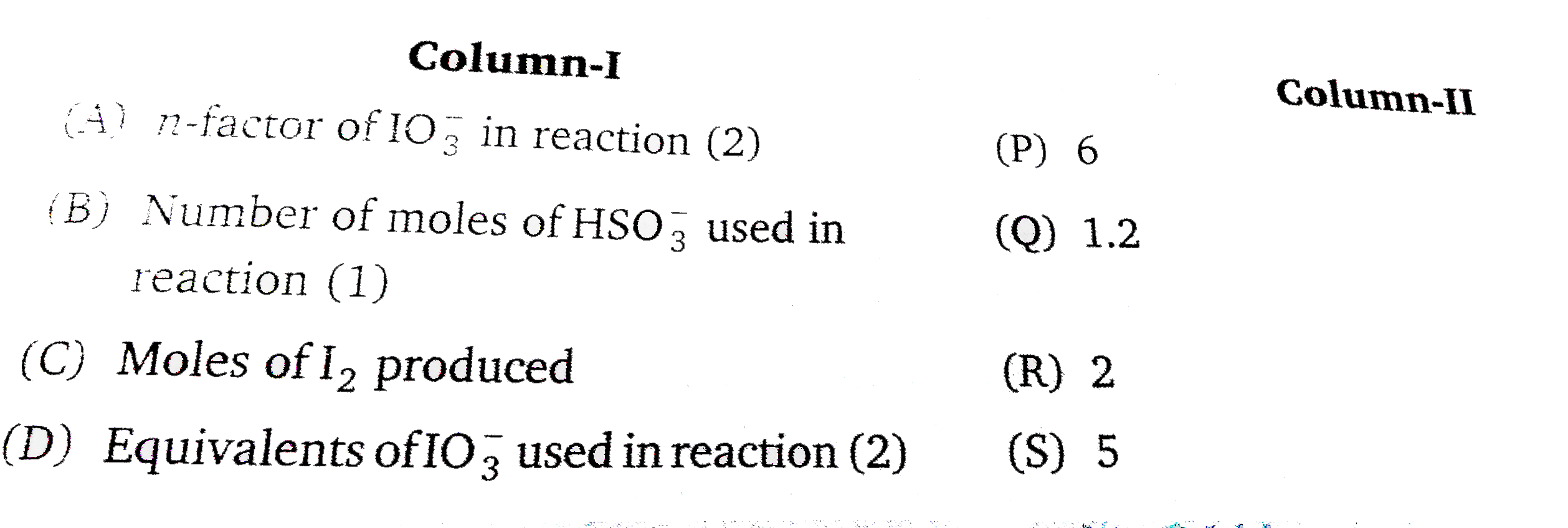A sample of raw material contain NaNO3. It contains some NaIO3 also. The NaIO3 can be used as a source of iodine, produced in the following reactions:
IO−3+HSO−3→I−+SO−4...................(1)
I−+IO−3→I2+H2O............(2)
One litre of sample solution containing 396 g NaIO3 is treated with stoichiometric quantity of NaHSO3. Now a substantial amount of solution is added to reaction mixture to bring about the reaction (2).

Step by step video & image solution for A sample of raw material contain NaNO_(3). It contains some NaIO_(3) also. The NaIO_(3) can be used as a source of iodine, produced in the following reactions: IO_(3)^(-)+HSO_(3)^(-) to I^(-)+SO_(4)^(-)...................(1) I^(-)+IO_(3)^(-) to I_(2)+H_(2)O............(2) One litre of sample solution containing 396 g NaIO_(3) is treated with stoichiometric quantity of NaHSO_(3). Now a substantial amount of solution is added to reaction mixture to bring about the reaction (2). by Chemistry experts to help you in doubts & scoring excellent marks in Class 11 exams.
Updated on:21/07/2023Topper's Solved these Questions
- STOICHIOMETRYBOOK - NARENDRA AWASTHICHAPTER - STOICHIOMETRYEXERCISE - Level 3 - Assertion - Reason Type Questions
15 Videos
- STOICHIOMETRYBOOK - NARENDRA AWASTHICHAPTER - STOICHIOMETRYEXERCISE - Level 3 - Subjective Problems
20 Videos
- STOICHIOMETRYBOOK - NARENDRA AWASTHICHAPTER - STOICHIOMETRYEXERCISE - Level 3 - One Or More Answers Are Correct
16 Videos
- SOLID STATEBOOK - NARENDRA AWASTHICHAPTER - SOLID STATEEXERCISE - Level 3 - Subjective Problems
1 Videos
- THERMODYNAMICSBOOK - NARENDRA AWASTHICHAPTER - THERMODYNAMICSEXERCISE - Level 3 - Match The Column
2 Videos
Similar Questions
Chile saltpetre, a source of NaNO3 also contains NalO3. The NalO3 can be used as a source of iodine, produced in the follwng reactions:
IO−3+3HSO−3→I−+3H++3SO2−4 ....(1)
5I−+IO−3+6H+→3I2(s)+3H2O ....(2)
One litre of chile salphere soltuion containg 5.08gNaIO3 is treated with stochiometric quanity of NaHSO3. Now an additional amount of same solution is added to reactiion mixture to bring about the secound reaction. How many grams of NaHSO3 are required in step i and what additional volume of chile salphetre must be added in step II to bring in complete conversion of I− to I2?
View SolutionIO−3+I−+H+→
View Solution
Knowledge Check
In the following reaction:
Cr(OH)3+OH−+IO−3→CrO2−4+H2O+I−AIO−3 is oxidising agentBCr(OH)3 is oxidisedC6e− are being taken per iodine atomDnone of theseThe reaction: ClO−3+I2→IO−3+Cl2
Ais possibleBdepends upon the state of productsCis not possibleDdepends upon the temperatureThe conjugate base in the following reaction
H2SO4+H2O→H3O++HSO−4AH2OBHSO−4CH3O+DSO2
Chile salt peter a source of NaNO3 also contains NaIO3 the NaIO3 is a source of I2 produced as shown in the following equation:
Step I: IOɵ3+3HSOɵ3+3SO2−4
Step II: 5Iɵ+IOɵ3+6H⊕→3I2(s)+3H2O
One litre sample of chile salt peter solution containing 6.6 g NaIO3 is treated with NaHSO3 Now an additional amount of same solution is added to the reaction mixture to bring about the second titration. Calculate the weight of NaHSO3 requried in step I and what additional volume of chile salt peter mist be added in step II to bring out complete conversion of Iɵ to I2.
View SolutionChile salt peter a soure of NaNO3 also contains NalO3. The NalO3 can be used as a surece of iodine produced in the following reactions :
Step 1 : lO−3+3HSO−3→l−+3H++3SO2−4
Step 2 : 5l−+lO−3+6H+→3l2+3H2O
One litre of chile salt peter solution containing amount of same solution is added to the reaction mixture to bring about the second reaction . How many grams of NaHSO3 are required in step 1 and what additional volume of chile peter must be added in step 2 to bring in complete conversion of l− to l2 ?
View SolutionBalance the ionic equation in alkaline medium Cr(OH)3+IO−3→I−+CrO2−4
View SolutionIn the reaction,
IO−3+SO2+4H2O→I2+SO2−4+8H+
The coefficient of SO2 is
View SolutionOne litre of a solution contains 18.9 g of HNO3 and one litre of another solution contains 3.2 g of NaOH. In what volume ratio must these solution be mixed to obtain a neutral solution ?
View Solution
